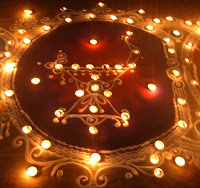Tuesday, October 13, 2009
My own space
Welcoming guest with the light of joy.
My favourite shelf in which all my selected collective articles are placed.
Rare olden style mirror.
Ganeshji holding all my art.
Rangoli, Kolam, Alpana
Rangoli is the popular floor art of India. It is an auspicious art of decorating courtyards and prayer halls in India . Some use rice flour to draw a rangoli which is the traditional medium to be used while others use sandstone or limestone powder.
The designs are then colored with various colored powdered dyes.
Although this floor-art is known as Rangoli commonly in many parts of India, it is known as Kolam in Tamil Nadu, Muggulu in Andhra pradesh, Rangavalli in Karnataka, Poovidal or Pookalam in Kerala, Chowkpurana in Uttar Pradesh, Madana in Rajasthan, Aripana in Bihar and Alpana in Bengal.
The colorful tradition of rangoli-making dates back to the Indus Valley Civilization (2500 B.C). Rangolis were often drawn with coarse rice flour since it served as a food source to nature's little critters like ants and crows. Rice flour is seen as an offering to Lakshmi, the goddess of rice and wealth. The goddess has the power to attract prosperity and to prevent poverty from entering the home.
Laxmi Pujan
Diwali marks the end of the harvest season in India . Farmers are thankful for the plentiful bounty of the year gone by, and pray for a good harvest for the year to come. Unfortunately this year was not so good regarding monsoon.
Traditionally this marked the closing of accounts for businesses dependent on the agrarian cycle, and the last major celebration before winter. The deity of Lakshmi symbolizes wealth and prosperity, and her blessings are invoked for a good year ahead.
There are two legends that associate the worship of Lakshmi on this day. According to the first legend, on this day, Lakshmi emerged from Kshira Sagar, the Ocean of Milk, during the great churning of the oceans, Samudra manthan.
The second legend relates to the Vamana avatar of Vishnu, the incarnation he took to kill the demon king Bali. Thereafter it was on this day, that Vishnu came back to Vaikuntha;

so those who worship Lakshmi on this day, get the benefit of her benevolent mood, and are blessed with mental, physical and material well-being.
When the sun sets in the evening and ceremonial worship is finished all the homemade sweets are offered to the goddess as "NAIVEDYA" and distributed as "PRASAD". Feasts are arranged and gifts are exchanged on this day gaily dressed men, women and children go to temples and fairs, visit friends and relatives. There is a peculiar custom in Maharashtra to lightly pound dry coriander seeds with jaggery and offer as Naivedya.
In villages cattle are adorned and worshipped by farmers as they form the main source of their income.
In south cows are offered special veneration as they are supposed to be the incarnation of Goddess Lakshmi and therefore they are adorned and worshipped on this day.
Subscribe to:
Posts (Atom)


































